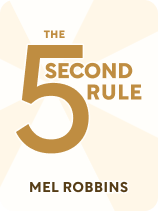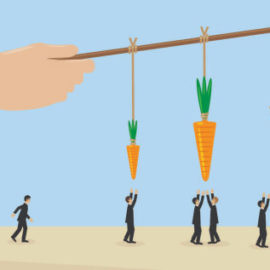

This article is an excerpt from the Shortform book guide to "The 5 Second Rule" by Mel Robbins. Shortform has the world's best summaries and analyses of books you should be reading.
Like this article? Sign up for a free trial here.
How can you take control of your life? How do you stop procrastinating and start spending time on your passions?
The 5 Second Rule by Mel Robbins discusses how you put the 5 Second Rule into practice. When you do this, you’ll be able to stop procrastinating, start focusing on your passions, and manage your anxiety.
Let’s look at how to take control of your life, one day at a time.
1. Stop Procrastinating
We’ll first address how, in conjunction with other methods, the 5 Second Rule can help learn how to take control of your life and overcome two types of procrastination: procrastinating on daily tasks and procrastinating on life changes.
Procrastinating on Daily Tasks
To understand how the Rule will help you stop procrastinating on daily tasks, it’s useful to first explain why we procrastinate. Robbins argues that we procrastinate to temporarily relieve stress as we avoid a difficult or daunting task and replace it with things that boost our mood for the moment (like scrolling on Buzzfeed instead of washing your car).
Knowing that procrastination is a response to stress, you can stop procrastinating on daily tasks using three strategies:
1) Stop beating yourself up. Robbins points out that feeling shameful over your procrastination only leads to more stress, which will continue the cycle of procrastination because you’ll want to avoid that stress. Forgiving yourself breaks the cycle so that your tasks feel less stressful and you’re less likely to avoid them.
2) Ask what the ideal future version of yourself would do. Robbins cites research showing that you’re more likely to do something that will benefit you in the long run if you visualize yourself in your ideal future, living as the person you want to grow into.
3) Use the Rule. Robbins advises counting down from five and beginning the task you’re procrastinating on when you reach one.
Procrastinating on Life Changes
Now that we’ve discussed how to use the Rule to stop procrastinating on daily tasks, let’s apply this approach to procrastination on major life changes: for instance, leaving a stressful housing situation, starting therapy, or switching jobs.
Robbins advises you to make big life changes before you feel prepared. Instead of waiting until you feel totally calm and in control of the outcome, it’s better to just start the process of change. However, many of us procrastinate on these changes because we worry that we’ll fail or that others will judge us for our big change.
According to Robbins, to overcome this fear-driven procrastination, you only need courage and discipline. You can build these traits by challenging the worries that are causing you to procrastinate. You must:
- Ask yourself, “What if my worries aren’t true?” What good things may happen instead?
- Consider, “Will it really matter if my worries are true?” If the worst-case scenario happens, will it really be the end of the world?
- Use the Rule to get yourself moving toward your goals.
2. Spend More Time on Your Passions
Once you stop waiting to make life changes in general, you can begin working toward one specific change: spending more time on your passions, the activities that excite you most. Robbins advises using the Rule for this because it’s often difficult to set aside time for your passions and learning to take control of your life.
According to Robbins, the Rule can help you get past your overthinking and take concrete steps to follow your passions. For example, if you have dreams of working in a big art museum but you currently live in a small town with few artistic resources, you may feel unprepared to move away even though you know it’s what you need to do to follow your desired career path. In this case, you can use the Rule to get yourself to look up apartment options in bigger cities with lots of career opportunities in the arts.
How to Discover and Act on a Passion
The first step in spending more time on your passions is to figure out what your passions are. Robbins states that you should consider:
- What are you curious about? Do you find yourself wondering about a specific topic, how something works, or how to do something? This curiosity may lead you to a pursuit that excites you.
- What do you see in others’ lives that you wish you had? For example, if you find yourself wishing you could be more like your friend who sings in a choir on the weekends, your passion may be a similar kind of creative outlet.
Once you identify an interest, Robbins suggests you act on your gut feelings to learn more about it. If you feel hesitant or find it difficult to set aside time to explore this interest, use the Rule to get yourself to begin researching your potential passion.
After identifying what you’re passionate about, you can begin to pursue that passion. Robbins states that the more you practice the skills needed for your passion, the easier it’ll be to set aside time for it. This is because, as with daily tasks, starting is the most difficult part. Eventually, you might be able to turn your passion into a full-time job.
3. Use the Rule to Regulate Anxiety
In addition to helping you stop procrastinating and start spending more time on your passions, Robbins explains that the Rule (when combined with other methods of coping) can help you calm yourself when you feel fearful and anxious. In the following section, we’ll explore Robbins’s strategies for managing anxiety to take control of your life.
Manage Mild Anxiety Using Gratitude
First, Robbins claims that when you’re feeling worried, intentionally thinking of something you’re grateful for can help you calm down. Thinking about the good things in your life causes your brain to release dopamine, naturally soothing your mood by altering your brain chemistry.
To implement this method, Robbins suggests counting backward from five to one, then thinking of something you’re grateful for. For example, if you’re worried about losing touch with a friend who’s moving away and you find yourself imagining the end of your friendship, count down from five to one and, when you get to one, think of how grateful you are to have spent so much time with this friend.
Reframe Intense Anxiety as Excitement
Robbins explains that sometimes, when anxiety is particularly intense, you won’t be able to simply redirect your thoughts toward something you’re thankful for. When you’re feeling so anxious that your body engages its fight-or-flight response, trying to suppress worrying thoughts will only make the anxiety worse. In these cases, you need a different method to handle anxiety: reframing it as excitement.
According to Robbins, when you have intense anxiety, your brain seeks to identify a specific threat around you as an explanation for why your body feels this way. If your brain can’t identify a threat, it’ll see this as a sign of more danger, causing you to spiral into more intense anxiety or even a panic attack.
However, because anxiety and excitement cause the same physical responses in the body (such as increased heart rate and sweaty palms), telling yourself that you’re excited rather than anxious can convince your brain that there’s no threat to worry about, halting the cycle of escalating anxiety. To implement this strategy, count down from five to interrupt your anxious thoughts, then start telling yourself out loud how excited you are, over and over, until your brain believes it.
Visualize the Future to Avoid Anxiety
Alternatively, count down from five then visualize a specific image of something in the near future that you’re excited about. Robbins asserts that this latter strategy is particularly effective in conquering specific recurring fears, when you can see the anxious situation coming and decide on an exciting scene to imagine before you start feeling anxious.
For example, if you know you’re afraid of parties with a lot of people, and you’ve been invited to a big party, you can make a plan: If you start feeling anxious before the party, you’ll visualize talking to your best friend at the party. Then, when you do start feeling anxious, you can imagine chatting pleasantly with your friend, convincing your brain that the physical sensations you feel are just excitement to see them.

———End of Preview———
Like what you just read? Read the rest of the world's best book summary and analysis of Mel Robbins's "The 5 Second Rule" at Shortform.
Here's what you'll find in our full The 5 Second Rule summary:
- Why counting down from five to one will help you assert agency over your life
- The different ways you can use the 5-Second Rule
- How to figure out what your passions are and work toward them






